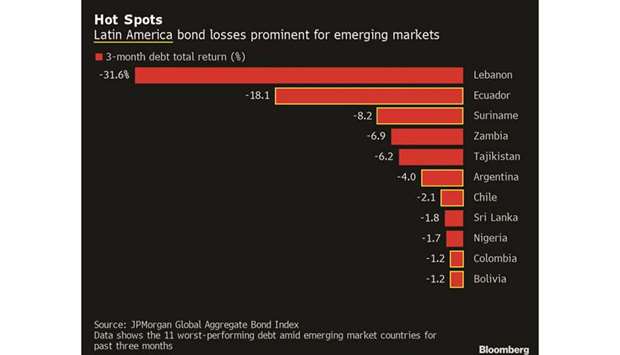A tide of social unrest across Latin America is driving bond spreads wider, and the increased risk premium is likely here to stay, according to investors.
In Chile and Colombia, which had some of the lowest borrowing costs in Latin America, angry citizens are forcing the governments to devote more resources to social welfare programs, even getting lawmakers to rewrite the constitution in Chile. That’s set to strain budgets and may force wider deficits with the risk of lower credit ratings in the future.
“Social unrest and greater demands from voters will probably lead to lower growth, greater fiscal costs, a continued push toward extremes in terms of policy making,” said Aaron Gifford, an emerging-market sovereign analyst at T Rowe Price Associates Inc in Baltimore, Maryland. “Inevitably, I think that means higher risk premium. That means wider spreads.”
While the nations faced street protests with unique domestic drivers, investors watched as a contagion effect pushed the currencies of Chile, Colombia and Brazil to record lows last week. The average yield on Latin American dollar-denominated debt rose in the past two months to its highest since 2016 in November, according to a Bloomberg Barclays index.
Even after Argentina’s bonds plummeted this year, spreads could widen further if the government fails to strike a deal with creditors in 2020. In Chile, the extra yield investors demand over US Treasuries – or country risk – is trading 30 basis points wider since violent anti-government protests erupted on October 18, forcing the government to raise spending and widen the fiscal deficit.
Election irregularities in Bolivia led to the sudden resignation of Evo Morales after almost 14 years in power, fuelling unrest in the Andean nation that didn’t subside until after an agreement to call new elections. The country’s bonds recovered after an initial sell-off.
And in Ecuador, President Lenin Moreno is dependent on congress to push through reforms to meet the terms of an International Monetary Fund programme. Bonds tumbled to a record after Congress rejected an initial package, and investors were hit with some of the biggest losses in emerging-market bonds in November.
Of the 11 worst performers for developing nation debt in the last three months, six are Latin American nations, according to JPMorgan indexes. “These are crazy events that are happening and very unforeseen at least in the typical day-to-day analysis we all do as investors,” said T Rowe’s Gifford. “We’re having to broaden our horizons and incorporate new risk factors and be a little bit more nimble.”
Maybe craziest of all is Suriname, where the president’s conviction for murder last week fuelled a rout in the South American nation’s only dollar bond, which was already suffering from deteriorating fiscal accounts.
All the same, pockets of stability still exist. Peru has low dollar debt and avoided lingering and widespread street protests despite President Martin Vizcarra’s decision to dissolve Congress. Brazil, meantime, outperformed in 2019 on the back of an advancing reform agenda, even after President Donald Trump reinstated steel tariffs.

.


